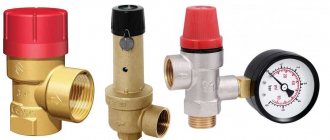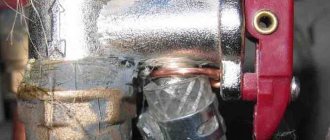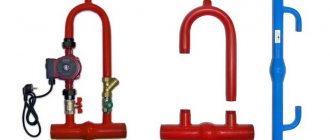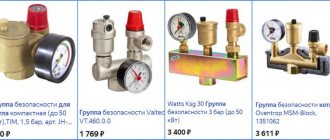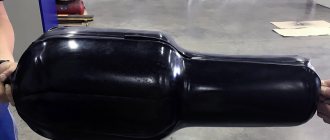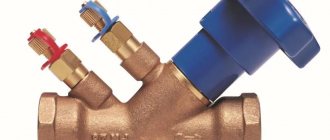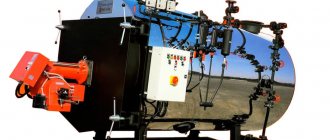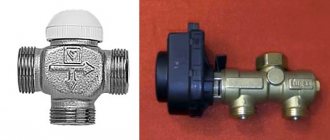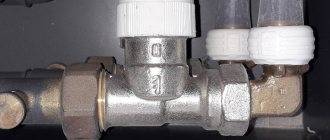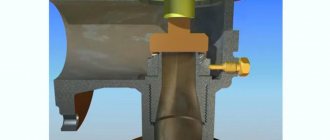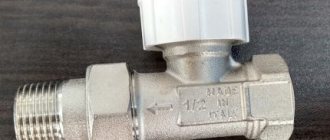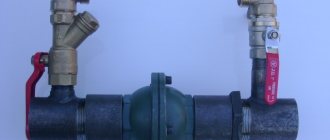Due to improper operation, temperature changes and pressure surges, failures may occur in the operation of autonomous heating systems. The negative consequences in such situations are critical: from the breakdown of individual components to the destruction of buildings and a serious threat to life.
A safety valve in the heating system will help eliminate dangerous risks. What is it and what is its principle of operation? We will consider these questions in our article. We will also analyze the types of such valves and indicate the main differences between them, consider the rules for installation in the heating system and provide recommendations for selecting and configuring safety valves.
Why are thermal relief valves necessary in principle?
It would seem that such a valve is not really needed.
After all, other devices also provide security. In particular, a safety valve that is triggered (broken) when the pressure is exceeded. It is often called that - disruptive or disruptive. On most heating systems you can see so-called “safety groups”. They consist of a pressure gauge indicating the pressure in the circuit, an automatic air vent and a safety blow-off valve (on the left in the illustration).
We will not focus on this device now - such valves have already been reviewed on our portal earlier.
Safety valve in the heating system
Such devices usually have a very simple design and a completely understandable principle of operation. When the pressure in the system rises to a certain set point, an operation occurs with the release of excess coolant. more about the operation of the safety valve in the heating system in a separate publication on our portal.
Well, so why “fence the garden” - there is already protection, right? If something goes wrong, for example, an increase in temperature in the circuit causes an increase in excess pressure, the valve will operate and the emergency will be prevented. Is it true?
Alas, this is not always 100% true. From excess pressure, yes, such protection should help. But with temperature, the question is more complicated.
Allowing the coolant to reach the boiling point (conventionally 100 ℃) in household boiler equipment is unacceptable! Therefore, the border of 95, maximum 100 ℃ should become “impassable”. Too high a temperature can lead to deformation of the boiler heat exchanger, rupture of the pipes of the laid circuit or connections between them. to massive vapor formation and the appearance of gas locks, to other not only unpleasant, but also extremely dangerous consequences.
Do not forget that in closed volumes, with increased pressure in the system, the boiling point shifts significantly higher. That is, if the temperature is uncontrolled, an extremely dangerous situation can arise. The water has already been superheated above the limit of 100 ℃, but there is still no boiling. However, as soon as the pressure drops (a leak has appeared or a relief tap or valve has opened somewhere), the entire superheated mass of water boils at once. Explosions happen such that they simply blow down walls.
These are the consequences of a boiler explosion!
For some reason, popular rumor attributes “increased explosiveness” to gas boilers. Apparently, due to occasional reports of explosions due to gas leaks. Meanwhile, this is not so. Indeed, gas leaks are dangerous in themselves. But the greatest danger is posed by solid fuel boilers, no matter how strange it may seem.
Meanwhile, this is explained quite simply. The combustion temperature of solid fuel is much higher than that of gas, and so is the energy potential. But monitoring and managing the combustion process is no example more difficult. “Tightening the wick” on gas or liquid fuel equipment is a matter of a few seconds. We are not talking about electric ones - the control there is even simpler and more sensitive. But the operation of a boiler using wood or coal is always characterized by significant thermal inertia, that is, even changes made to the fuel combustion mode do not work immediately. It is not for nothing that many solid fuel boilers are equipped with special cooling circuits - this is a necessary measure in order to prevent overheating above critical temperatures.
Yes, the pressure safety valve should take over the protection duty here. But, firstly, the operating accuracy of such spring devices is low; ±30% of the nominal value is considered the norm. For some systems, such “punctuality” is not enough. And secondly, and this is the main thing, if the heating system is equipped with an open type expansion tank, then the pressure valve becomes completely useless. It will not in any way protect the system from possible overheating and reaching the boiling point.
In open-type heating systems, the pressure safety valve becomes a useless “decoration”.
Therefore, a protection system is needed that would trigger when the upper temperature threshold is reached.
Such a “line of defense” is also necessary in other circumstances. For example, a solid fuel boiler operates in a system with forced circulation of coolant. If, due to power supply problems, the pump suddenly stops and circulation stops, an extremely dangerous situation can arise. This means that the “temperature” protection system must be completely energy-independent, capable of helping out in any case.
These types of devices include thermal relief valves.
Features of three-way safety valves
We should also talk about a device that is not so well known to consumers - a three-way valve with a manual or electric switch. It is used in heating systems with low temperature circuits.
The fuse design is equipped with three holes, one of which is input, two are output. The flow of the medium is controlled by a damper made in the form of a ball or rod. The moving fluid is redistributed by rotations.
Three-way fuses are appropriate for condensing boilers and in cases where several different systems operate from one heating equipment
Let's imagine a situation: the house has a heating scheme with a system of conventional radiators and heated floors. The technical requirements for the operation of the second option provide for not too high coolant temperatures.
The boiler heats water at the same temperature for all systems. In such conditions, there is a need for a redistributing device, the tasks of which are perfectly handled by a three-way valve.
It is responsible for the following functions:
- delimitation of areas;
- distribution of flux density by zones;
- facilitating the mixing of coolant from the main supply/return branches to send colder water into the underfloor heating pipeline than into the radiators.
In order not to constantly control the temperature of the medium yourself, you need to pay attention to valve models equipped with a servo drive.
This device operates from a sensor installed in the low-temperature circuit. When the temperature changes, a shut-off mechanism is activated, opening or closing the liquid supply from the return line.
We talked in more detail about the types of three-way valves for heating and the criteria for its selection in the next article.
Purpose and installation location
Closed heating systems operate under a certain pressure. A significant increase in operating pressure leads to equipment failure. Connections may leak, plastic parts and elements may burst. In the most unfavorable situations, the boiler heat exchanger may explode. This is already very dangerous and threatens not only the floor flooded with hot coolant, but also burns. After all, the temperature is serious.
The overpressure relief valve must protect the heating system from excessively high pressure. As long as the system parameters are within normal limits, it does not manifest itself in any way. Although the pressure in the system gradually increases from the moment the boiler starts, the expansion tank compensates for it, maintaining a stable state of the system. But it may not do this indefinitely, although, with proper calculation, it is enough for standard situations. If the expander fails to cope with the task, the pressure begins to rise. When it exceeds the threshold, the excess pressure relief valve is activated. It simply releases part of the coolant, thereby stabilizing the emergency situation.
That is, the excess pressure relief valve in the heating system works in emergency situations. That is why it is also called “emergency”. And also “discharge”, “drain”, “protective” and “explosive”. All these are names of the same device.
What does a safety (emergency) valve for heating look like?
As is clear from the description, when the pressure increases above a certain limit, a certain amount of coolant is simply released from the system. If you came to the boiler room and a puddle formed under the emergency valve, it means there was an emergency situation during which the pressure increased. There is no other alarm. So these traces are worth paying attention to. It is worth immediately checking the functionality of the valve itself and the membrane tank. Most likely, they are the reason. If you do not pay attention to these symptoms, after a while you may encounter problems: either something will “fly” in the system, or the water heating boiler will rupture.
We recommend: How to attach lining: step-by-step instructions for covering walls with your own hands + video
Installation location of the emergency heating valve - on the supply pipeline, near the boiler
Of all the equipment in an individual heating system, the most dangerous is the boiler. Therefore, the excess pressure relief valve is installed either directly on the boiler itself (if there is an appropriate outlet for installation) or on the supply line immediately after the boiler. The distance is small - 20-30 cm from the body. If the boiler does not have this type of fittings (indicated in the description), then it is installed in the so-called safety group or placed separately. The safety group is placed at the outlet from the supply line immediately after the boiler (before the first branch and any other device), on which a pressure gauge, automatic air vent and excess pressure relief valve are installed.
Design features and operation
Consider in detail how a safety valve with a spring works. Its body is made using hot stamping technology from brass. The main working element is a spring, which presses the membrane that covers the seat.
Valve with spring mechanism
On the rod connected to the handle there is a washer that serves as a stop for the upper end of the spring. Using the handle, the position of the washer and, accordingly, the clamping force on the membrane are changed. The spring is made of steel; the handle, seals and membrane are made of polymer materials.
The operating principle of the device is as follows: as long as the parameters of the coolant do not exceed the specified maximum permissible values, the membrane tightly closes the hole. When the situation is close to an emergency, as the pressure increases, the superheated coolant (a mixture of water and steam) lifts the membrane, overcoming the resistance of the spring. Thanks to this, the steam-water mixture is discharged out through a special hole. After dumping the excess volume of the steam-water mixture, the pressure in the pipeline decreases, and the coolant again loses the ability to compress the spring.
Note! The device can operate cyclically if the boiler is operated at maximum power, heating the coolant to 90-95 degrees. This mode of operation has a negative impact on the protective device - after several operations the blast valve begins to leak due to loss of tightness.
Excess pressure relief valve: types, device, principle of operation
There are two types of “demolition” - lever-load and spring. Lever-load units are not used in heating private houses, so it makes no sense to consider them. Let's talk about spring "resetters". We see their structure in section in the figure below.
Spring safety valve device for heating system
A shut-off and control element or a valve itself is inserted into the metal body, which takes on the pressure of the coolant. It is pressed by a spring, the elastic force of which is designed for a certain load. When the pressure in the heating system acts on the valve with a force greater than the force of the spring, it begins to compress and the disk rises. A certain amount of coolant is drained into the opened gap, the pressure drops, and the spring blocks the flow. This is how the overpressure relief valve works.
Advantages and disadvantages
The relief valve has the following advantages:
- eliminates water hammer and pressure surges;
- prevent the appearance of air pockets in the liquid media transportation system;
- simple design that is easy to maintain and repair;
- relatively low cost;
- possibility of automatic control and pressure release;
- simple installation technology;
- unpretentiousness to operating conditions;
- do not require frequent maintenance.
Flaws:
- presence of operating error;
- increased wear of critical parts;
- limited service life.
Simple valve design
Determination of the conditional cross section and response threshold
It is easy to determine the cross-section of the emergency valve - it must be no less than the diameter of the supply pipe. Otherwise, it will not work as it should. When installing not as part of a safety group, we make the tap with a slight slope towards the boiler (it can be vertical, but definitely not in the opposite direction). If your wiring is inch, we use the same pipe to make an outlet, and install a blast valve of the same cross-section. This is understandable.
Can be part of a security group or installed separately
The response threshold is determined based on the operating pressure of the system. For normal operation it should be 20-30% higher. If your heating operates at 1.2 Bar, then the excess pressure relief valve should operate at 1.45-1.55 Bar.
It is not always possible to find an emergency valve with the required response value. You can either take one with similar parameters, or find an adjustable one (there is one for 1.5 Bar).
Installation Features
A device for releasing excess water pressure is installed taking into account the presence of an expansion tank in the heating system - the valve is activated after the volume of the membrane tank is exhausted.
Boiler safety group
The safety device is mounted on a pipeline connected to the boiler outlet pipe, at a distance of 20-30 cm from it.
In this case, the following conditions are met
:
- if the valve is installed separately and not as part of a safety group, a pressure gauge is installed in front of it to control the pressure;
- It is prohibited to install shut-off valves (taps, valves) between the boiler and the safety valve, as well as a circulation pump (it is not designed for pumping a mixture of water and steam);
- a drain pipe is attached to the outlet pipe of the valve, which drains excess coolant into the return pipe or into the sewer;
- in a system with natural coolant circulation, the emergency valve is installed at the highest possible point.
The emergency device installed on the heating boiler must be changed after 7-8 operations, since the valve loses its tightness due to wear of the plate and spring.
Types of overpressure relief valves
There are several generally accepted classifications of safety valves. Depending on the method of action, there are:
- direct-acting valves - devices are activated by direct action of the working medium on the spring mechanism;
- indirect action - operate under the influence of an external pressure source (hydraulic fluid or electric drive).
Based on the type of load on the membrane, the device is divided into the following types:
- cargo - the most common mechanism for adjusting the working pressure in the system;
- spring - the pressure of the working medium is counteracted by a lever that presses on the rod, holding it in the closed position;
- lever-spring – hybrid devices equipped with a spring and a lever mechanism;
- magnetic spring valves are indirectly acting valves equipped with an electromagnetic drive.
Modern manufacturers offer other types of excess pressure relief valves.
For example, there are thermal relief valves on the market that respond not to an increase in pressure, but to an increase in the temperature of the working environment. They may have a remote or built-in temperature sensor, which operates on the basis of a heat-sensitive liquid located in a bellows.
When the water temperature heats up to 95-100 degrees, the liquid in the capillary tube of the sensor flask puts pressure on the bellows, which opens the rod and drains the superheated water to normalize the pressure.
We recommend that you read: Shut-off valves and their use in pipeline systems
According to the control method, the valves are divided into two groups: manual and automatic - they are controlled, respectively, manually or are activated automatically when the pressure of the working medium increases. In addition, there are regulated and unregulated. Adjustment allows you to set any water pressure threshold.
Depending on the type of working medium, there are water and air. The former remove excess liquid, the latter discharge excess gases from the system, preventing airing of circuits in closed heating systems.
There are also control valves equipped with a built-in thermostat, which changes the throughput of the device, slightly opening or completely blocking the outflow of the working medium. Such devices are usually installed at the entrance to the heating radiator in the room.
Nuances of proper installation
During the installation of shut-off valves, several rules should be strictly followed:
- The valve is installed strictly in the direction of coolant flow. To avoid mistakes, the product body must be marked with an arrow indicating the working direction.
- Paronite gaskets can be used to seal connections, provided that they do not reduce the diameter of the passage hole. Otherwise, the valve will exert more hydraulic pressure than intended.
- The device must be installed so that other elements of the heating system do not exert additional pressure on its body.
- It is highly advisable to install a mesh in front of the check valve for rough cleaning. This will make it possible to prevent solid particles from entering the locking mechanism, which, in turn, can lead to a violation of the tightness of the device when closed.
Another important point: before installation, you need to once again make sure that the valve is selected correctly.
For example, for schemes with forced circulation, any type of device is suitable, but for gravitational systems, only a rotary petal device without a spring. Since the coolant moving by gravity will not be able to cope with the resistance of the spring.
Criterias of choice
The safety valve in the heating system performs an important function - it prevents the boiler from boiling over and reduces the pressure that has risen to the limit values.
It is recommended to choose a spring device, but it is important to pay attention to the following points
:
- range of values at which the valve is able to operate (selected in accordance with the parameters of the heating system);
- type of valve - open or closed (in the first case, the coolant is discharged into the atmosphere, in the second - into the return pipeline);
- plate lifting height (selected based on throughput).
The selection of a pressure relief device is based on the technical characteristics of the heating system - the thermal power of the boiler unit and the maximum pressure of the medium in the pipeline.
Mechanism
The emergency relief valve must operate in a timely manner, which depends on the characteristics of its mechanism, the key elements of which are the rod, spring and disc.
Safety valve device
The main characteristic of the valve is the percentage difference between the pressure in the pipeline at the moment the rod begins to move and the pressure when the passage is fully open to discharge excess coolant. This parameter also depends on the nominal pressure in the heating system. The response speed of the device depends on the operating pressure in the system - the higher it is, the faster the valve should open.
It is important that the adjustment mechanism does not come into contact with the coolant. The coils of the spring must not touch each other. If the valve is idle for a long time, the spring may “stick” - in this case, the device will not be able to operate on time. A special rod for manually retracting the spring makes it possible to check the operation of the valve from time to time. The relief valve also provides frost protection.
Note! The valve opens completely when the pressure in the heating system increases by 10% of the set value, and closes completely when the pressure level drops by 20% relative to the response parameter. It is recommended to choose for installation a model whose response pressure exceeds the operating parameters of the heating system by 20-30%.
Pipeline supply
To prevent hydraulic resistance from affecting the operation of the safety device, the diameter of the valve must correspond to the diameter of the supply pipe or be larger.
Pipeline option
Attention! To reduce hydraulic losses when the coolant pressure is applied to the plate, the emergency valve is mounted with a slope towards the boiler unit.
Material of manufacture
Brass is usually used to make the body, since this material has low thermal expansion, corrosion resistance, durability and an affordable price.
We recommend: Technical characteristics of a quartz heater - TeplEko company
The control unit is made of heat-resistant plastic, which does not change its geometry and retains the necessary rigidity even under the influence of a coolant brought to a boil.
Tips for choosing the optimal model
Before choosing a specific safety equipment, you must familiarize yourself in detail with the technical characteristics of the boiler installation.
The operation of the safety valve is negatively affected by sub-zero temperatures. Therefore, a fairly important characteristic for the device is the presence of frost protection
Do not neglect to study the manufacturer’s instructions, which indicate all the limit values.
Several criteria play a decisive role in choosing a heating device:
- Boiler performance.
- The maximum permissible medium pressure for the thermal power of heating equipment.
- Safety valve diameter.
You should check that the pressure regulator in the device has a range that includes the parameters of a particular boiler. The response pressure should be 25-30% greater than the operating pressure required for stable operation of the system.
The higher the operating pressure, the less time the device should spend on operation. The gap between the pressure at the start of movement and when the shutter is fully opened should be 15% for a nominal value less than 2.5 atm, 10% for higher parameters
The diameter of the safety valve cannot be less than the connector of the inlet pipe. Otherwise, constant hydraulic resistance will not allow the fuse to fully perform its immediate tasks.
The optimal material for manufacturing equipment is brass. It has a low coefficient of thermal expansion, which prevents destruction of the housing from exposure to strong pressure.
The control unit is made from heat-resistant plastic materials that maintain the required rigidity even when in contact with boiling liquid.
How to choose a safety valve
The main criterion for choosing a safety device is the technical parameters of the heating system specified in the design documentation.
Most modern closed heating systems use standard direct acting brass safety valves.
They are suitable for installation in systems operating on diesel, gas or electric boilers. When a critical temperature and pressure is reached, the safety valve almost instantly stops further heating of the working environment and prevents an accident.
Simple brass safety valves are designed to exceed the pressure of the working medium up to 3-6 bar.
When choosing a valve for diesel, gas and electric boilers, you need to select safety devices that can withstand pressure 20-25% higher than the normal operating pressure in the system.
For solid fuel boilers operating on peat, briquettes or coal, you need to choose the type of waste dumps more carefully, because solid fuel cannot stop burning instantly and continues to heat water for some time after switching off.
They are suitable for modern thermal relief valves with a maximum operating pressure of 10 bar. The same applies to solid fuel boilers in open heating systems, in which relief valves work most effectively by responding to an increase in operating temperature rather than pressure.
Important! When choosing a safety device, be sure to study the technical documentation for the boiler equipment. Manufacturers usually specify the required maximum pressure and temperature specifications for which relief valves are purchased.
It is not advisable to choose cheap engineering equipment from Chinese manufacturers: it is usually not of high quality and quickly breaks down. An indicator of wear is an increase in the number of valve operations.
We recommend that you read: Why do you need a check valve for water and how to install it correctly?
Clamping mechanism
Lever-load safety valves are designed for heavy loads and a pipe diameter of at least 200 mm, therefore they are used in industrial heating systems.
For individual heating of a private house, it is better to purchase a device with a spring mechanism; this is a standard, reliable and frequently used type of relief valve.
If you are on a budget, we recommend purchasing a more efficient thermal relief valve, which will prevent the problem before the pressure in the heating system seriously increases.
Lifting height
Pressure relief valves have different valve lift heights:
- Low-lift model PS-350. Low-lift . The height of the shutter in low-lift valves does not exceed 1/20 of the seat diameter. They have a relatively low throughput and a simple design. Used in lines with liquid coolant. As a rule, low-lift safety valves are sufficient for a heating system with a water circuit with a power of up to 40-43 kW. To prevent an accident in such systems, it is necessary to discharge a small volume of coolant.
- Full lift . The height of the valve in full-lift valves is greater than or equal to the diameter of the seat. As a rule, these are lever-load mechanisms, more expensive and complex in design. Full-lift valves have a high capacity and can be installed on lines in which gases, steam or compressed air circulate.
Full lift model PN 16.
Mechanism response speed
Based on response speed, safety valves are divided into proportional and on-off.
In heating systems of a private home, it is better to use proportional valves; again, they are sufficient for most systems. The shutter cover of such devices opens gradually, in proportion to the increase in pressure in the line, and accordingly, the volume of coolant discharged increases proportionally. Such valves do not self-oscillate, they maintain the correct pressure level and are cheaper.
Two-position safety valves are distinguished by instantaneous detonation and full opening of the valve. This mechanism allows you to quickly release large volumes of coolant, but creates the risk of water hammer: due to the rapid release of a large amount of coolant liquid, the pressure in the line significantly decreases, after which the valve closes sharply. Therefore, it is recommended to install two-position safety valves on lines with a compressible medium (air, gas, steam).
Diameter
The diameter of the pressure relief valve in the heating system should not be less than the connector of the supply pipe. Otherwise, the constant hydraulic pressure will interfere with the operation of the mechanism.
Manufacturer
Since safety valves have a fairly simple design, and modern models are in most cases made of brass using the same technology, there are no critical differences between valves from different manufacturers.
The difference between some is higher quality processing, inspection and testing of devices and a guarantee of a long service life without leaks - from 15 years. There are manufacturers whose safety valves we can recommend above all: VALTEC , WATTS , Protherm .
Types of devices and principle of operation
The design of the bleed valve includes two mandatory components: a shut-off part, consisting of a seat and a valve, and a force adjuster. There are several types of equipment that have their own characteristics. They are classified according to certain criteria.
Classification #1 - by clamping mechanism
In heating systems of private houses, apartments and low-power industrial installations, preference is given to the spring type of product.
The main working element of the device is the spring. It supports the membrane that covers the seat. A washer is placed on the rod connected to the handle, against which the upper part of the spring rests. The position of the washer and the pressing effect on the membrane are adjusted with a handle
The device has a simple and reliable structure, compact dimensions, the ability to be combined with other elements of the security unit, and an affordable price. The compression force of the spring mechanism depends on the pressure parameter at which the valve operates. The tuning range is affected by the elasticity of the spring itself.
The operating principle of spring fuses is as follows:
- the valve of the device is affected by the flow of water;
- the movement of the coolant is limited by the spring force;
- critical pressure exceeds the compression force, lifting the spool rod upward;
- the liquid is sent to the outlet pipe;
- the internal volume of water is stabilized;
- the spring closes the bolt, returning it to its original position.
The body of the springy device is made of high-quality, high-strength brass using hot stamping technologies and techniques. Steel is used in the production of springs. The membrane, seals and handle are made of polymers.
Some brands produce equipment with factory settings already installed. The range also includes models that can be adjusted at the installation site during commissioning.
Valves can be open or closed. In the first design option, the coolant is discharged into the atmosphere, in the second, it is discharged into the return pipeline
Lever-weight fuses are not so widespread. They are rarely installed in private autonomous systems with a boiler. Operation is concentrated in the industrial sector in large production facilities, where the diameter of pipelines is at least 200 mm.
The force on the rod in such mechanisms is provided not by a spring, but by a weight hung on the lever. It moves along the length of the lever, adjusting the force with which the rod will be pressed against the seat.
The lever-load valve opens when the pressure of the medium from the bottom of the spool exceeds that coming from the lever. After this, the water leaves through a special discharge hole.
Adjustment of lever-load fuses is done by moving the rod along the lever. In order to prevent its unauthorized or accidental change, the load is secured with bolts, covered with a special casing and locked with a lock.
The actuation pressure, as well as the range of settings, is determined by the length of the lever and the weight of the load. Lever fuses are not inferior to spring devices in terms of reliability, but are more expensive. The devices are installed on flanged connecting parts of pipes with a nominal diameter of 50 or more.
Classification #2 - according to the height of the shutter lift
In low-lift safety valves, the shutter rises no higher than 0.05 of the seat diameter. The opening mechanism in such equipment is proportional.
It is characterized by low throughput and the most primitive design. Low-lifting equipment is used on vessels with liquid media.
Full lift devices are equipped with a two-position opening mechanism. They are equipped not only with vessels with liquids, but also with systems in which compressible media circulate (compressed air, steam, gas)
Full-lift devices have a higher shutter lift. This means that their throughput capacity is much better than that of the previous version, so they are able to discharge larger volumes of excess coolant.
Classification #3 - by response speed
The shutter cover of the proportional safety valves opens gradually. Typically, the amount of opening is proportional to the increase in pressure exerted on the inner surface. Simultaneously with the rise of the mechanism, the volumes of discharged coolant gradually increase.
The design of the devices does not limit the possibility of their use in a compressible medium, but they still predominate in systems with water and other liquids.
Among the advantages of safety valves with proportional response speed are low price, simplicity of design, absence of self-oscillations, portion opening at the level of values necessary to maintain specific operating parameters
A feature of two-position valves is instantaneous operation with full opening after reaching the pressure limits in the system at which the safety valve opens.
Experts recommend using these devices in compressed environments. Their main disadvantages include the presence of characteristic self-oscillations of the shutter.
When installing a two-position valve in a heating system with a liquid coolant, it should be taken into account that during a sudden opening of the valve, a large amount of water will be discharged.
This will cause the pressure to drop too quickly. The valve will close instantly, resulting in a water hammer. Proportional devices do not cause such risks.
Installation and configuration rules
When planning to independently install a safety valve for heating, you should prepare a set of tools in advance. The work cannot be done without adjustable wrenches and wrenches, a Phillips screwdriver, pliers, a tape measure, and silicone sealant.
Before you begin, you need to determine a suitable location for installation. It is recommended to install the safety valve on the supply pipeline near the boiler outlet pipe. The optimal distance between elements is 200-300 mm.
All compact household fuses are threaded. To achieve complete tightness when screwing, it is necessary to seal the pipe with tow or silicone. It is not advisable to use FUM tape, since it does not always withstand critically high temperatures.
In the regulatory documentation that comes with each device, the installation process is usually described step by step.
Some key installation rules are the same for all types of valves:
- if the fuse is not mounted as part of a safety group, a pressure gauge is placed next to it;
- in spring valves, the spring axis must have a strictly vertical position and be located under the device body;
- in lever-load equipment, the lever is placed horizontally;
- On the section of the pipeline between the heating equipment and the fuse, the installation of check valves, taps, gate valves, and a circulation pump is not allowed;
- to prevent damage to the body when rotating the valve, you need to select the wrench from the side where the screwing is carried out;
- the drain pipe, which discharges the coolant into the sewer network or return pipe, is connected to the outlet pipe of the valve;
- the outlet pipe is not connected to the sewer directly, but with the inclusion of a funnel or pit;
- in systems where fluid circulation occurs according to a natural pattern, the safety valve is placed at the highest point.
The nominal diameter of the device is selected on the basis of methods developed and approved by Gostekhnadzor. In resolving this issue, it is wiser to seek help from professionals.
If this is not possible, you can try using specialized online calculation programs.
To reduce hydraulic losses during medium pressure on the valve plate, installation of emergency equipment is carried out with a slope towards the boiler installation
The valve adjustment is affected by the type of clamping structure. Spring devices have a cap. The pre-compression of the spring is adjusted by rotating it. The adjustment accuracy of these products is high: +/- 0.2 atm.
In lever devices, adjustments are made by increasing the mass or moving the load.
After 7-8 operations in the installed emergency device, the spring and plate wear out, as a result of which the tightness may be broken. In this case, it is advisable to replace the valve with a new one.
Required tools and materials
To install the valve you will need:
- adjustable wrench;
- fum - ribbon or tow;
- special paste for sealing joints.
Connection diagram
For example, let's look at the installation diagram of the device in front of the hot water heater in the apartment.
Work progress
Each product designed for releasing excess pressure is equipped with installation instructions, which should be carefully studied before starting work. Before installation, you also need to disconnect the water heater from the network and drain the water from it. The valve must be placed on the cold water supply up to the shut-off valve. The valve installation sequence is as follows:
- marking the installation site;
- removing a part of the pipe of a size corresponding to the length of the device body;
- threading the ends of pipes:
- covering the threaded part with tow or fum tape;
- screwing the valve onto the pipe thread;
- connecting to another pipe a pipe leading to the sewer system.
- tightening the threaded connection using an adjustable wrench;
- sealing the joint with a special paste;
- setting up the device in accordance with the passport values (if necessary).
Design
A typical safety valve for a boiler has a collapsible design and consists of the following main elements:
Frame . Usually made of brass and shaped like a tee. On its sides there is a lower inlet threaded hole, a side outlet pipe and an upper seat on which the shaped seal is seated.
Locking group . It is a spring-loaded pulley with a cylindrical (disc) end locking element, onto which an elastic rubber seal in the form of a cup (disc) is placed.
Lid . A black cap made of heat-resistant polymer is screwed into the upper threaded pipe of the brass body, holding the spring-loaded rod in the working position. On the upper edges of the lid there are protrusions along which the upper cap, shaped at the bottom, slides, connected to the locking rod. When turned to a certain angle, the cap rises along with the rod and opens the side pipe - this allows you to use the safety valve for heating always open in manual mode.
Cap. The polymer part is usually red in color with a ribbed side surface, and is screwed to the hollow inside of the rod with a screw. The gentle protrusions at the bottom of the cap, when rotated, fall on the teeth of the lid - the handle rises along with the spring-loaded shutter and opens the side channel, allowing you to relieve pressure manually.
Adjusting washer . The inner wall of the cover has a thread in which the adjustment nut rotates; when lowered down, it compresses the spring - thus increasing the valve response threshold. When the nut is unscrewed upward, the spring weakens and the actuation pressure decreases. For turning, the nut is equipped with a transverse slot in the upper part for a flat-head screwdriver.
Valve for water heating boilers - design and appearance
Adjusting the mechanism for proper operation
The safety valve is adjusted after completion of installation work and complete flushing of the system. Spring devices can be adjusted by rotating the adjusting knob (colored plastic cap), the rotation compresses or decompresses the spring that puts pressure on the spool. In lever-load trucks, this is done by hanging a load on the lever.
It is necessary to set the set pressure, full opening and closing:
- The setting pressure should be set slightly higher than the maximum operating pressure of the boiler.
- The full opening pressure should not exceed the maximum permissible standards of the most vulnerable element of the system, usually the boiler heat exchanger, designed for 3 or 2 bar, and in some Russian models even 1.5 bar.
- The valve closing pressure must be set slightly higher than the minimum allowable for system operation.
Combined operation of valve and expansion tank
The expansion tank in the heating system is designed to stabilize the pressure. But the mistake is the opinion that with such a tank a safety valve will not be needed. The tank may not work correctly and may simply be out of air.
It is also a mistake to believe that the valve can take on the functions of an expansion tank - releasing pressure as soon as it has increased slightly. This device is not structurally designed for multiple operations and after several resets, a constant leak appears through it...
The safety valve is designed only to operate in the event of an emergency increase in pressure above the norm, after which the personnel must take measures to eliminate the causes of this situation.
Final tips
If you are keenly interested in the safety of the boiler room and the reliable operation of heating equipment, then we recommend that you carefully study the range when purchasing fittings. The fact is that new useful products are appearing on the market that cannot be reviewed within the scope of this article, but they may be useful to you.
Operating moment. Monitor the condition of safety valves in order to detect activation in time and understand the reasons. Direct the heat release devices into the sewer funnel with a burst of stream - an unexpected splash of water in the boiler room and wet footprints will make it clear that an emergency situation has occurred.
In what cases does the valve usually trip?
There are four typical situations when a heating valve is triggered.
- Fluid is pumped into the system using a hand pump without pressure control, or automatic filling turns out to be defective and produces increased pressure.
- The heating system is faulty - the expansion tank was not installed or was turned off by the tap.
- The expansion tank is not working properly - there is no air in it.
- Boiler boiling with massive release of steam.
In which systems is pressure protection installed?
- The heating system of a private house is equipped with a safety valve. Even if automated boilers have rapid shutdown protection when the temperature rises, it is recommended to equip the system with an independent emergency pressure valve.
- It is also installed in the hot water supply (DHW) system, with the exception of the case when the water is heated by a flow method....
- Emergency pressure relief is installed in individual closed circuits of the system, heated by a heat exchanger or other energy source.
- In various hydraulic (air) systems operating under pressure or with a compressor….
What response pressure, which valve to choose
The standard set response pressure of the safety valve for a home heating system is 3 atm. The usual preliminary air pressure in the expansion tank is 1.5 atm. The operating pressure in the system after heating to maximum temperatures is 2.0 – 2.5 atm.
Accordingly, when this value increases, the situation becomes “emergency”. When 3.0 atm is reached, or slightly lower, the valve should begin to operate. Let us recall that the lowest strength limit of individual heating equipment, low-quality expansion tanks, for example, is only about 4.0 atm, and it is often exceeded when manually pumping coolant...
You should only choose a safety valve for your heating system from a reputable manufacturer. This device is simple, but it must be made accurately, and not all residents will like the explosion of the boiler...
What to do if water drips through the relief valve
The nature of the problem depends on whether the water from the safety valve is dripping or flowing in a stream.
If the coolant is dripping, this indicates normal operation of the emergency valves, but the heating system is operating at the limit, since the temperature in the coolant in it is increased and the pressure exceeds the norm. It’s easy to check whether the drops are the natural operation of the mechanism - just lower the operating temperature, allowing the coolant to cool. If the water drainage stops, then everything is in order, you just need to prevent further reheating.
A mechanism clogged due to contaminated coolant. Particles of sand and dirt prevent the rod from completely closing, which causes leakage.
If the drops do not stop or the coolant is discharged in large quantities, in a stream, this indicates a malfunction of the safety valve: the spring, rubber or silicone seal are worn out, the fitting is clogged, as a result of which it does not fit tightly. It is not recommended to disassemble the mechanism yourself; in this case, it is necessary to replace the relief valve (issue price 400-900 rubles).
Why might a valve leak?
The pressure relief valve in the heating system can leak for various reasons. In some situations, this is an acceptable natural process; in other cases, a leak indicates a malfunction of the device.
Leakage of the protection valve can be caused by the following reasons:
- Damage to the sealed rubber cup or disc as a result of repeated use. If during repairs a replacement part cannot be found on sale or is not included in the package, you will have to replace the device completely.
- In spring types, the opening of the side drain pipe occurs gradually; at borderline pressure values or short-term surges, the valve may partially operate and drip, which does not indicate its malfunction.
- Leakage can be caused by incorrect settings or malfunctions of the expansion tank - damage to its membrane, air escaping through a depressurized housing or a damaged nipple. In this case, sharp pressure surges are possible as a result of water hammer, causing periodic short-term leakage of coolant through the safety valve.
- The cause of leakage in some adjustable valves is fluid seeping down the stem through the top during actuation.
- If a back pressure is created at the outlet pipe above the device's response threshold, a leak will also occur.
The safety valve of steam boilers is designed to protect them from excess pressure in the system caused by various factors, and is a mandatory element when operating this type of equipment. There is a wide range of safety devices on sale from Chinese, domestic and European manufacturers, which are characterized by a relatively low cost. When purchasing, it is rational to choose a protective group from several devices, which additionally includes a pressure gauge and an air release valve.
